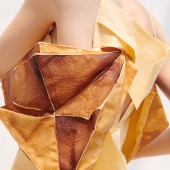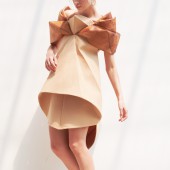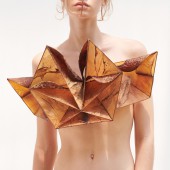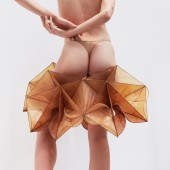Bio Melanin Fibre Fashion by Khajornsak Nakpan |
Home > Winners > #127014 |
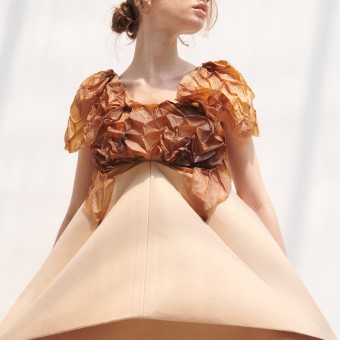 |
|
||||
| DESIGN DETAILS | |||||
| DESIGN NAME: Bio Melanin PRIMARY FUNCTION: Fibre Fashion INSPIRATION: This study investigated the use of soil to create a substitute textile material to create fashion garments for the future in Thailand. It aims to maximize the value of natural resources in response to climate change, based on the concept of living in harmony with nature. UNIQUE PROPERTIES / PROJECT DESCRIPTION: A bio-fibre was synthesized from soil bacteria through a process that holistically considered the full production cycle, ensuring that it generated no waste. The final material contained melanin pigments similar to human skin tones, with hues comparable to those of people from Thailand. The results of this study can be further developed on a commercial scale to support sustainability. The proposed technology has applications in fashion design, where it can enhance individuals’ aesthetics and self-esteem. This research can help advance Thailand’s national development strategy to drive creativity through scientific innovation. OPERATION / FLOW / INTERACTION: This study applies a scientific experiment process to discover a new material with remarkable properties that will contribute to both restoring Thailand’s growth foundation and improving the security of its natural resource base. This will help to promote conservation, by limiting the use of the country’s natural capital and managing it to create balance in the environment, which will enhance the quality of life for its citizens. In the future, human garment design will rely on new developments in bioscience technology, which will exhibit the potential integration of aesthetic philosophy and innovation, resulting in the effective design of a textile substitute. PROJECT DURATION AND LOCATION: The project started in August 2018 in Thailand and finished in April 2021 in Thailand, and was awarded winning and exhibited in many museums and galleries such as Thailand, China, Spain, Romania and USA. It was also published in Academics fields like international conferences and journals for example; Pratt Institute (New York), University of Montreal (Mexico), Falling Wall LAB (Germany) and Ewha Womans University (Korea). FITS BEST INTO CATEGORY: Fashion, Apparel and Garment Design |
PRODUCTION / REALIZATION TECHNOLOGY: The use of soil innovation to synthesize textile substitutes and create garments for the future has expanded from the study of the integrity cycle of ‘soil’ and the changes in ‘soil’ properties. The experimental process synthesizes bio-fibre and melanin from Streptomyces, bacteria naturally present in soil, into textile substitutes or bio-cellulose. This is a clean production technology and does not generate residual toxic substances or environment pollution. The result is a substitute material which is friendly to the human body and is biodegradable. The goal of the artist designer is to design and create pilot products and design cycles for circular fashion. The artist designer believes good products are designed to not only respond to basic human needs or facilitate human living but must also be developed, analysed, and designed to understand elements such as designers, producers, operators, and consumers. This builds a circulatory system which conforms to the same goal: recycling throughout the production process so that no waste is created. This requires a return to nature that starts by ensuring that all processes involved in production, such as designing, manufacturing, transportation, or distribution, are complete processes. SPECIFICATIONS / TECHNICAL PROPERTIES: A series of bio garment dimensions are approximately 60 x 120 x 100 cm. and ornaments are around 72 x 140 x 23 cm. TAGS: soil; melanin; textile substitute; bio-fibres; sustainable production; Thailand RESEARCH ABSTRACT: In the unprecedented time of natural disasters and global pandemics, people are changing their behaviors. We find a way to live through the crises while building economic strength. One of the ways to our survival is an environment-friendly development and growth, starting from restoring natural resources. To respond to human needs, we need to produce products that are environmentally aware. In designing a product, the aim is to ensure that it is reusable, recyclable, and biodegradable. The whole production process leaves no waste behind. For these reasons, the research project on using soil to create a textile substitute material aims to study and synthesize bio-fibre from good bacteria which is abundant in nature. It has brown pigments which are similar to melanin which determines human skin colours. The pigments can be used in producing garments. This demonstrates the relationship between humans and nature. It also has the potential to be developed for commercial purposes and support creative business growth, and economic stability for small and medium businesses in the future. CHALLENGE: This research, which is in line with the 12th National Economic and Social Development Plan and uses the aforementioned ‘cycle of circular design’, is presented as a pilot product design to illustrate the feasibility of commercial production. These processes can contribute to the overall development and future growth of the creative economy. This is because countries have come to realize that current global situations have dramatically affected humanity’s way of life. Catastrophic global crises reflect choices that contradict scientific advancement; for example, rapidly changing fashion trends have led to excessive waste in the fashion industry, which have upset the ecological balance of nature. Humanity must, therefore, urgently realize and seek ways to restore and conserve the environment. One important duty for designers is to create product design concepts that promote ecological balance through circular fashion design. ADDED DATE: 2021-06-18 09:02:04 TEAM MEMBERS (1) : IMAGE CREDITS: All images, Photos and Video credits go to Khajornsak Nakpan. PATENTS/COPYRIGHTS: Patents 1. 1903002625 9 October, 2019 2. 2001006387 6 November, 2020 |
||||
| Visit the following page to learn more: https://www.facebook.com/khajornsak.n/ | |||||
| AWARD DETAILS | |
 |
Bio Melanin Fibre Fashion by Khajornsak Nakpan is Winner in Textile, Fabric, Textures, Patterns and Cloth Design Category, 2021 - 2022.· Read the interview with designer Khajornsak Nakpan for design Bio Melanin here.· Press Members: Login or Register to request an exclusive interview with Khajornsak Nakpan. · Click here to register inorder to view the profile and other works by Khajornsak Nakpan. |
| SOCIAL |
| + Add to Likes / Favorites | Send to My Email | Comment | Testimonials | View Press-Release | Press Kit |
Did you like Khajornsak Nakpan's Textile Design?
You will most likely enjoy other award winning textile design as well.
Click here to view more Award Winning Textile Design.


